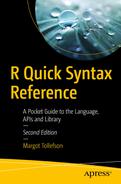
R is a programming language that provides the user with powerful data and graphical analysis options. R is both flexible and broad. From tasks as simple as adding two numbers to tasks as complex as fitting an ARIMA model, R is capable of crunching the numbers.
The purpose of R Quick Syntax Reference is to provide the reader with the basic syntax of R. Often an R user gets stuck if, for example, a mode is incorrect or a logical test does not work. Because the full spectrum of R packages uses the same fairly simple syntax, R Quick Syntax Reference provides the reader with the necessary information to get unstuck and run and create all R functions and code.
The R language is based on the language S, a high-level programming language developed mainly by Richard A. Becker, John M. Chambers, and Allan R. Wilks in the AT&T laboratories in 1975. The R version of the language first became available in 1993 and was developed by Ross Ihaka and Robert Gentleman at the University of Auckland , New Zealand.
R is open source and is a GNU project . As open-source code, the R language is free and constantly being improved. The R Foundation for Statistical Computing maintains the program, and the R Development Core Team currently does the development. Packages for specific analysis techniques are added often. At the present time, there are over 10,000 packages available in R. Most users will use only a few packages. We discuss using R at the command prompt in R Quick Syntax Reference. We also cover the integrated development environment (IDE), R Studio. RStudio was founded by J.J. Allaire and became available in a beta version in 2011 and as a regular version in 2017. The Chief Scientist at R Studio is Hadley Wickham.
This book is about the S3 and S4 versions of R— S3 and S4 standing for the third and fourth versions of S, the commercial program on which R is based. The two versions run concurrently. Even though version S4 is quite different from S3, it is necessary to know the syntax of S3 in order to use S4. And S3 remains a powerful, flexible language in its own right—hence, this book.
Part I covers the basics of R. Chapter 1 describes how to download and install R and R Studio for the Windows, Mac, and Linux operating systems and also how to download packages. Because keeping separate folders for different projects is very useful, Chapter 1 gives instructions for running R and R Studio from different folders. It also gives the methods for updating the R and R Studio programs themselves.
Chapter 2 introduces the R prompt, gives a sample calculation, and describes the three parts of R—objects, operators, and assignments. We also describe the four windows of R Studio and what R scripts are. Chapter 3 covers the assignment of names to objects, demonstrates the ls() function that allows you to see the objects in a folder, and discusses the operators in R and R Studio.
Part II describes R objects. Objects have modes, classes, and types. Chapter 4 lists the modes and types and describes some of them. It also shows how modes and types differ. Chapter 5 discusses some of the classes and how classes differ between S3 and S4 R.
Part III covers functions. Chapter 6 starts with a list of the 30 default packages in R and follows with instructions on how to use functions. Because packaged functions all have help pages, the chapter provides instructions on how to access and use the help page of a function in both R and R studio. Chapter 7 describes how to create a function. Chapter 8 explains how to run a function—with a detailed approach to the argument list.
Part IV focuses on importing and exporting data in R and R Studio and methods for creating and manipulating some kinds of object. Chapter 9 describes several methods for importing data, gives a number of functions to create data objects, and discusses some random-number generators. It gives an example of data mining Twitter. Chapter 10 gives several methods for exporting from R and R Studio. A table of matched importing and exporting functions is included. Chapter 11 gives a number of functions that operate on objects—to bind objects together, to find descriptive qualities of an object, to assign qualities to an object, to aggregate an object in some way, or to apply functions to portions of an object.
Part V covers flow conditioning commands and functions. Chapter 12 presents the flow conditioning statements, and Chapter 13 supplies examples of them. Chapter 14 describes the two flow conditioning functions and gives examples.
Part VI discusses functions related to formatting and outputting output, looks at the results from packaged functions and at what some of the default packages contain, and provides some tips for using R and R Studio. Chapter 15 gives some rounding functions and some functions for outputting from a function. It also gives some functions that vary according to the class of the object on which the function operates and that summarize the results of the function, either textually or visually. Chapter 16 takes a look at the contents of the packages base, stats, and graphics and glances at the datasets, grDevices, methods, and utils packages. Chapter 17 describes how to deal with some common frustrations in R. More information is given on outputting from functions, plus an example of a recursive function and some advice on using R.
I would like to thank the writers of the R Development Core Team at the Comprehensive R Archive Network. Without their help pages, this book could not have been written. I would also like to thank the editors at Apress, Steve Anglin and Matthew Moodie, for guiding my progress; and my husband, Clay Conard, for his support and patience over the last few months.
Table of Contents
About the Author

is a retired consulting statistician residing in the tiny town of Stratford in the corn and soybean fields of north-central Iowa. She started using the S-Plus language in the early 1990s and happily switched to R about ten years ago. Margot enjoys writing her own functions in R—to do plots and simulations as well as to implement custom modeling and use published statistical methods. She earned her graduate degrees in statistics from Iowa State University in Ames, Iowa.
